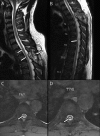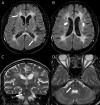Cerebral small vessel disease due to a unique heterozygous HTRA1 mutation in an African man
- PMID: 32042911
- PMCID: PMC6936311
- DOI: 10.1212/NXG.0000000000000382
Cerebral small vessel disease due to a unique heterozygous HTRA1 mutation in an African man
Abstract
Objective: To describe the case of an African patient who was diagnosed with cerebral autosomal recessive arteriopathy with subcortical infarcts and leukoencephalopathy (CARASIL).
Methods: Case report and literature review.
Results: We present a 39-year-old Gabonese man who developed progressive gait difficulty at the age of 32, followed by insidious tetraparesis, urinary sphincter disturbance, spastic dysarthria, cognitive dysfunction, and seizures. Brain imaging was performed many years after disease onset and revealed diffuse confluent white matter lesions and lacunar infarcts. He tested negative for acquired white matter disease, but genetic screening detected a genetic variant of HTRA1 gene (G283R), which has not been previously reported.
Conclusions: CARASIL is a disease that usually affects Asian patients. This case report describes a unique case of an African patient diagnosed with CARASIL and a novel genetic mutation in HTRA1 that has not been previously described in the literature.
Copyright © 2019 The Author(s). Published by Wolters Kluwer Health, Inc. on behalf of the American Academy of Neurology.
Figures


References
-
- Yanagawa S, Ito N, Arima K, Ikeda S. Cerebral autosomal recessive arteriopathy with subcortical infarcts and leukoencephalopathy. Neurology 2002;58:817–820. - PubMed
-
- Hara K, Shiga A, Fukutake T, et al. . Association of HTRA1 mutations and familial ischemic cerebral small-vessel disease. N Engl J Med 2009;360:1729–1739. - PubMed
-
- Chen Y, He Z, Meng S, Li L, Yang H, Zhang X. A novel mutation of the high-temperature requirement A serine peptidase 1 (HTRA1) gene in a Chinese family with cerebral autosomal recessive arteriopathy with subcortical infarcts and leukoencephalopathy (CARASIL). J Int Med Res 2013;41:1445–1455. - PubMed
-
- Cordeiro IM, Nzwalo H, Sá F, et al. . Shifting the CARASIL paradigm report of a non-Asian family and literature review. Stroke 2015;46:1110–1112. - PubMed
LinkOut - more resources
Full Text Sources
